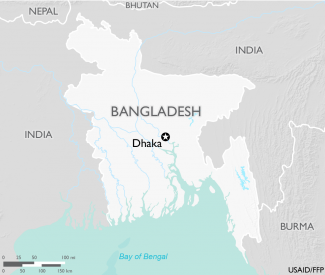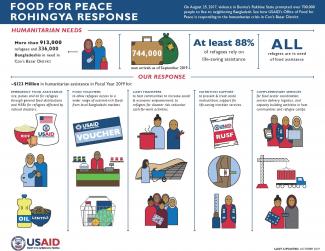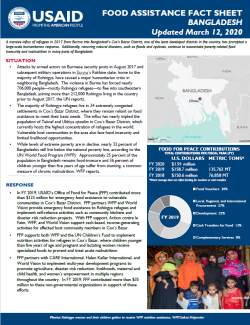March 12, 2020
A massive influx of refugees in 2017 from Burma into Bangladesh’s Cox’s Bazar District, one of the least developed districts in the country, has prompted a large-scale humanitarian response. Additionally, recurring natural disasters, such as floods and cyclones, continue to exacerbate poverty-related food insecurity and malnutrition in many parts of Bangladesh.
Situation
- Attacks by armed actors on Burmese security posts in August 2017 and subsequent military operations in Burma’s Rakhine state, home to the majority of Rohingya, have caused a major humanitarian crisis in neighboring Bangladesh. The violence in Burma has forced nearly 706,000 people—mostly Rohingya refugees—to flee into southeastern Bangladesh, joining more than 212,000 Rohingya living in the country prior to August 2017, the UN reports.
- The majority of Rohingya refugees live in 34 extremely congested settlements in Cox’s Bazar District, where they remain reliant on food assistance to meet their basic needs. The influx has nearly tripled the population of Teknaf and Ukhiya upazilas in Cox’s Bazar District, which currently hosts the highest concentration of refugees in the world. Vulnerable host communities in the area also face food insecurity and limited livelihood opportunities.
- While levels of extreme poverty are in decline, nearly 32 percent of Bangladeshis still live below the national poverty line, according to the UN World Food Program (WFP). Approximately 25 percent of the population in Bangladesh remains food-insecure and 36 percent of children younger than five years of age suffer from stunting, a common measure of chronic malnutrition, WFP reports.
Response
- In FY 2019, USAID’s Office of Food for Peace (FFP) contributed more than $123 million for emergency food assistance to vulnerable communities in Cox’s Bazar District. FFP partners WFP and World Vision provide emergency food assistance to Rohingya refugees and implement self-reliance activities such as community kitchens and disaster risk reduction projects. With FFP support, Action contre le Faim, WFP, and World Vision support cash-based, income-generating activities for affected host community members in Cox’s Bazar.
- FFP supports both WFP and the UN Children’s Fund to implement nutrition activities for refugees in Cox’s Bazar, where children younger than five years of age and pregnant and lactating women receive specialized foods to prevent and treat acute malnutrition.
- FFP partners with CARE International, Helen Keller International, and World Vision to implement multi-year development programs to promote agriculture, disaster risk reduction, livelihoods, maternal and child health, and women’s empowerment in multiple regions throughout the country. In FY 2019, FFP contributed more than $35 million to these non-governmental organizations in support of these efforts.
Food for Peace Contributions
Total Contributions:
| Fiscal Year | U.S. Dollars | Metric Tons |
|---|---|---|
| Fiscal Year 2020 | $1.91 million | - |
| Fiscal Year 2019 | $165.4 million | 135,671 |
| Fiscal Year 2018 | $150.6 million | 76,858 |
Country Specific Information
- 2016 Bangladesh Comprehensive Risk and Resilience Assessment
- FY 2015 Bangladesh Country Specific Information (Revised)
- Bangladesh Food Security Country Framework FY 2015-2019
- 2014 Bangladesh BEST Analysis
Related Resources
- USAID Feed the Future initiatives in Bangladesh
- Bangladeshi Women Grow Healthier Food and Savings for their Families
- Meet 8 Rohingya and Bangladeshi Aid Workers
- Facing Bangladesh Monsoon Season
- Unsung Heroes of Bangladesh: Bangladeshi Community Volunteers Help Rohingya Refugees from Burma
- The Complexities of Feeding the World's Largest Refugee Camp
- US Announces $18 million in Humanitarian Assistance to the World Food Program to Fight Food Insecurity among Rohingya Refugees - January 25, 2018 press release
- US Assistance in Response to the Rohinya Refugee Crisis in Bangladesh - September 28, 2017 press release
- Teaching People Not Just to Fish, But to Build Businesses Too
- Smart Phones and a Web-Based Software Improve Program Monitoring



